Not many places afford you the opportunity to take a vehicle ‘over sand’, and visitors to Nantucket should not miss out on all of the fun and excitement that beach driving entails. Whether you’re heading to Great Point in the Coskata-Coatue Wildlife Refuge or taking the family to 40th Pole for some north shore fun, a vehicle adventure on the beach should top your list for your Nantucket getaway.
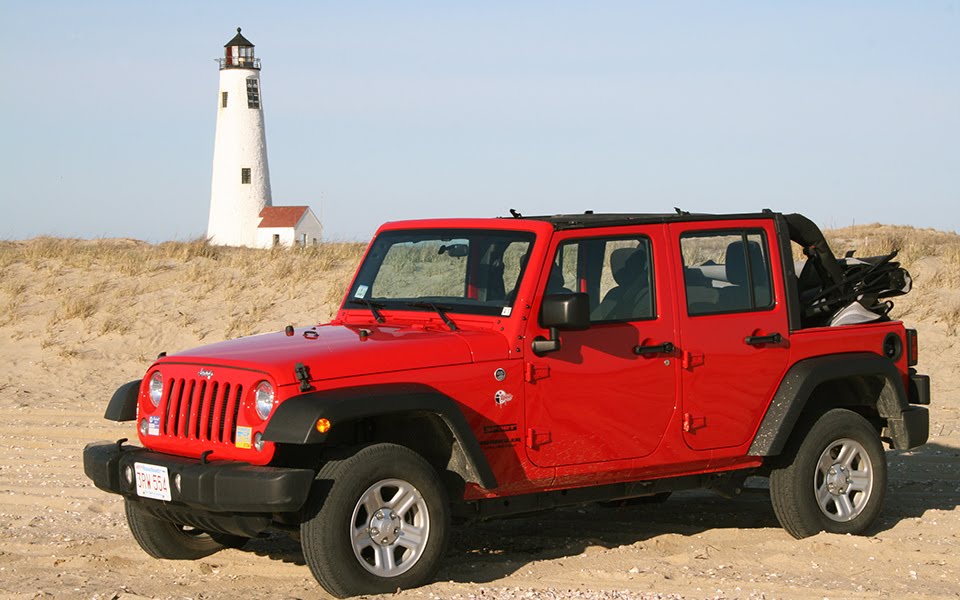
For those who have never had the chance to drive on the beach, we know all about the anxiety and nerves associated with a first experience airing your tires down and changing to four-wheel drive before hitting the soft sand. And regardless of your beach driving bona fides, Nantucket has multiple beach permits as well as some beaches where driving is prohibited so some local expertise is necessary to know the ins and outs.

Author: Lucas Johnston, Office Manager at Young's
Can you drive on the beaches in Nantucket?
You can drive on select beaches on Nantucket as long as you have the appropriate permits.
There are two beach driving permits for Nantucket: the Town of Nantucket Beach Vehicle Permit and the Trustees Over Sand Vehicle Permit.
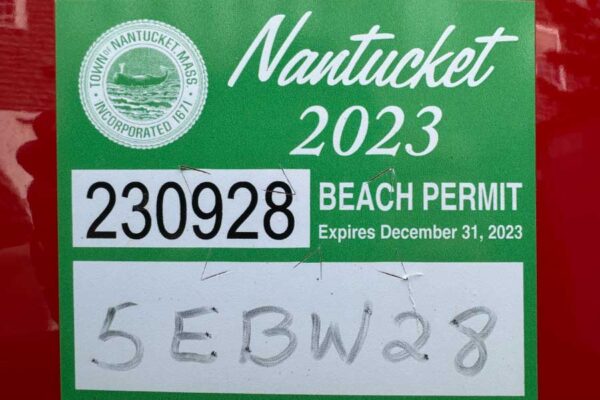
The Town of Nantucket Permit allows access to 40th Pole, Eel Point, Nobadeer Beach, Smith’s Point (Madaket), and Cathcart Beach.
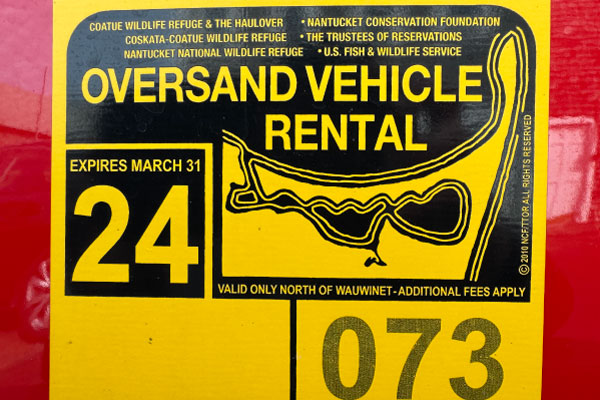
The Trustees’ Oversand Vehicle Permit gives you access to Great Point and the Coskata-Coatue Wildlife Refuge.
The Town of Nantucket Beach Vehicle Permit can be purchased online or at the Public Safety Facility at 4 Fairgrounds Road. The Town Permit is good for the calendar year in which it was purchased. The Trustees’ Oversand Vehicle Permit can also be purchased online or at the Trustees’ Wauwinet gatehouse in season. The Oversand Vehicle Permit is valid from April 1 to March 31.
All of Young’s Bicycle Shop’s rental Jeeps come with both permits, and most island rental car companies equip their 4x4 vehicles with the two permits. For Town of Nantucket beaches, there are no additional costs or day passes required for rental vehicles that have the Town permit.
However, to access Great Point and the Coskata-Coatue Wildlife Refuge, rental vehicles must have the Oversand Vehicle Permit, and renters must purchase a day pass. The day use fee is $50, and each additional day is $10 for vehicles rented for multiple days. The day pass can be purchased at the Trustee’s gatehouse or online (Young’s Bicycle Shop provides the information necessary to purchase the day pass).
Which Nantucket beaches can you drive on?
Now that we have the necessary permits, which beaches are the best for driving?
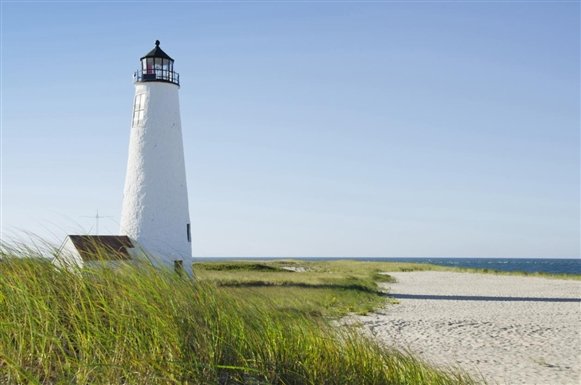
Great Point and the Coskata-Coatue Wildlife Refuge are worth the effort and time it takes to get to them and those locations earn our top recommendation.
Great Point, along with its eponymous lighthouse, is the most northern point of Nantucket and provides the longest stretch of beach driving on Nantucket. Coatue comprises the strip of sand, dune, and vegetation that extends west forming the northern barrier of Nantucket Harbor but is closed to rental vehicles. Coskata is the area that connects the pair of peninsulas of Coatue and Great Point. Teeming with wildlife, the Great Point and Coskata-Coatue areas provide great places for fishing, birding, and hiking.
Conditions vary throughout the year depending on coastal flooding and nesting shorebirds so check with the Trustees at 508-228-5646 #2 before heading out to make sure it's open. There's also a place to refill your tires near the Gatehouse when you get off the beach, making it a breeze to transition back to road driving.
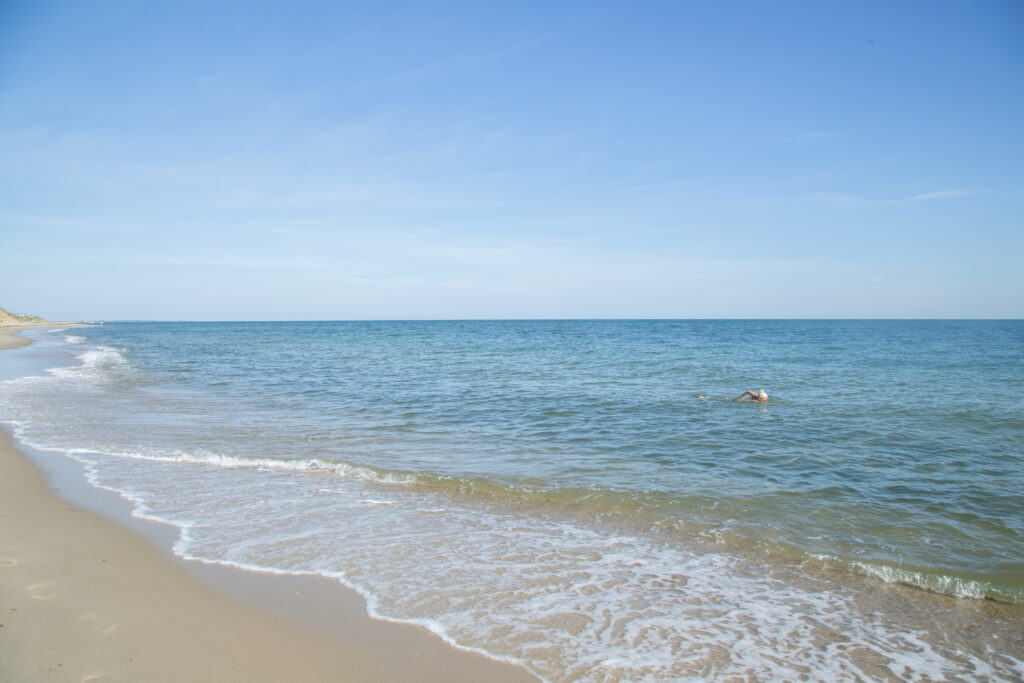
40th Pole and west towards Eel Point are great destinations for families that want to drive and park directly on the beach. Located on the north shore west of family-friendly Dionis Beach, 40th Pole and west towards Eel Point provide the perfect setting for a day of swimming and picnicking. The north shore is calmer and shallower than the south shore making this an ideal spot for younger beachgoers. It does get crowded here during the summer so you might want to think about heading out early.
There are no rangers or air stations at 40th pole, so drive carefully on the beach and take it slow on your way back to town where you'll find air at gas stations.

Nobadeer Beach is another popular spot to drive on the beach and spend the day playing in the surf or relaxing with a book. Nobadeer is on the south shore so expect stronger currents and possible wave action; surfers and boogie boarders can have a lot of fun under the right conditions. Nobadeer Beach abuts the airport, and the occasional jet or small aircraft coming in for a landing is par for the course. Nobadeer can also be busy with a limited amount of space for vehicles on the beach so get an early start or take a look before airing down your tires and hitting the sand (you can always park off the beach and walk down).
Similar to 40th Pole, there are no rangers or air stations at Nobadeer, so drive carefully on the beach and take it slow on your way back to town where you'll find air at gas stations.
There are some beaches that we do NOT recommend. Driving on Low Beach in Sconset is difficult as the sand is extremely soft, and even experienced drivers can get stuck. Smith’s Point in Madaket can also be soft and is not always open due to nesting birds. Please always consider your ability and current conditions when driving on any of Nantucket’s beaches.
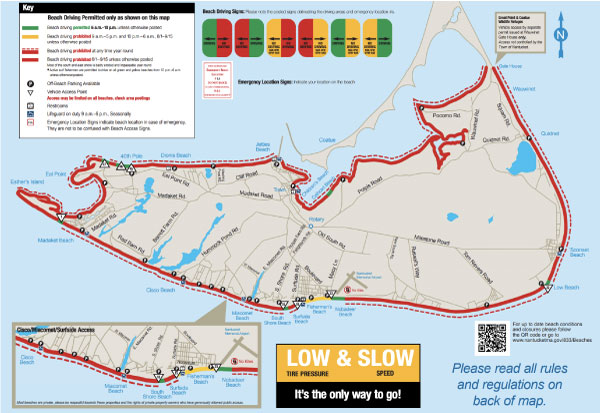
Check out the Town of Nantucket's Beach Map and brochure for more information.
How to drive on Nantucket beaches
Obviously, no one wants to get stuck in the sand as that ends all of the beach driving fun very quickly. Following some simple steps, you’ll be cruising between the dunes and the ocean without any issues.
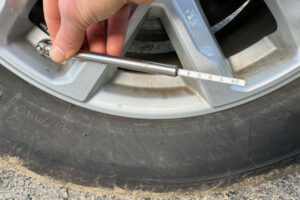 It starts with a rhyme: Low and Slow. The Low is for low tire pressure: before heading out onto the beach, all tires must be aired down to 12 to 15 p.s.i. Failing to do this will result in the vehicle getting stuck; trust us, it happens a lot here. Don’t forget to reinflate the tires once you’re back from the beach (there is a free refill station past the Gatehouse in Wauwinet for Great Point, and each of the gas stations on the island have refill pumps as well).
It starts with a rhyme: Low and Slow. The Low is for low tire pressure: before heading out onto the beach, all tires must be aired down to 12 to 15 p.s.i. Failing to do this will result in the vehicle getting stuck; trust us, it happens a lot here. Don’t forget to reinflate the tires once you’re back from the beach (there is a free refill station past the Gatehouse in Wauwinet for Great Point, and each of the gas stations on the island have refill pumps as well).
Now, the Slow part. Drive Slow! Jamming on the gas will often cause the vehicle to sink into the sand, but more importantly, pedestrians have the right of way and going too fast can result in accidents. The speed limit is 15 mph, and 5 mph near pedestrians. Please be courteous, and don’t forget that driving on the beach is a privilege and not a right.
Only drive onto the beach at designated access points, and don’t drive on the dunes or below the high-water mark (the point to which the water advances at high tide and leaves a clearly visible line of debris in the sand). Nantucket’s beaches are natural treasures, but they are also fragile environments. In order for all of us to continue to have access by vehicle to these amazing beaches, we must obey these rules and regulations to protect these resources. As the Town of Nantucket puts it in their beach driving brochure: “Please Respect Our Fragile Environment.”
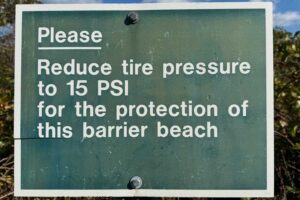

It starts with a rhyme: Low and Slow. The Low is for low tire pressure: before heading out onto the beach, all tires must be aired down to 12 to 15 p.s.i. Failing to do this will result in the vehicle getting stuck; trust us, it happens a lot here. Don’t forget to reinflate the tires once you’re back from the beach (there is a free refill station past the Gatehouse in Wauwinet for Great Point, and each of the gas stations on the island have refill pumps as well).
After airing the tires down, switch the vehicle to four-wheel drive. Much like airing the tires down, failure to switch to four-wheel drive will cause the vehicle to get mired in the sand. This also happens more than you think it would.
Now, the Slow part. Drive Slow! Jamming on the gas will often cause the vehicle to sink into the sand, but more importantly, pedestrians have the right of way and going too fast can result in accidents. The speed limit is 15 mph, and 5 mph near pedestrians. Please be courteous, and don’t forget that driving on the beach is a privilege and not a right.
Only drive onto the beach at designated access points, and don’t drive on the dunes or below the high-water mark (the point to which the water advances at high tide and leaves a clearly visible line of debris in the sand). Nantucket’s beaches are natural treasures, but they are also fragile environments. In order for all of us to continue to have access by vehicle to these amazing beaches, we must obey these rules and regulations to protect these resources. As the Town of Nantucket puts it in their beach driving brochure: “Please Respect Our Fragile Environment.”
Do rental vehicles come with Nantucket Beach Permits?
As mentioned above in the Permits section, Young’s Bicycle Shop’s rental Jeeps come with both the Town of Nantucket Beach Permit and the Trustee’s Oversand Beach Permit, which still requires the day pass to be purchased. Our rental Jeeps also come with a shovel, jack, jack board, tire gauge and spare tire. Each customer that rents a Jeep from us receives a lesson on beach driving in addition to these tools.
However, once you are on the beach, it is your responsibility to have your tires at the correct pressure, obey the rules for beach driving, and if you get stuck, you will need to get yourself out whether that’s by digging (fill in any holes after you’re unstuck) or calling for a tow out. Don’t be intimidated as it’s all a part of the adventure.
Nantucket beach driving FAQs
What happens if I get stuck?
First of all, if you follow our instructions and obey the rules of driving on sand you won't have an issue. However, should you run into trouble our rental Jeeps are equipped with a jack, board and shovel. Shovel out the sand blocking the wheels and undercarriage, and decrease tire pressure to 10 p.s.i. but no lower.
Young’s Bicycle Shop does NOT provide towing services. If you are in the Coskata-Coatue Wildlife Refuge, you can call the Trustees’ Gatehouse for help during business hours (508-228-0006 or 508-228-5646). If it is after hours, call Barrett’s Beach Towing (508-364-8875). Even if you get unstuck before the tow truck arrives, the tow company may charge you for the full-service call.
Can I drive an All-Wheel Drive vehicle?
All-Wheel Drive vehicles are NOT allowed in the Coskata-Coatue Wildlife Refuge. These vehicles are not suited to driving on Nantucket beaches.
How do I let air out of my tires?
All of our rental Jeeps come with a tire gauge. The reverse side of the tire gauge head has a handy nub that is perfect for deflating tires. First, remove the valve cap from the valve of the tire, and then push the nub of the tire gauge into the center of the tire valve. You will hear air being released as you hold pressure on the tire gauge and valve. Go slow and easy, and check the tire pressure with the gauge frequently to ensure you don’t let out too much air. Once you have reached 15 p.s.i., replace the valve cap and move onto the next tire.
Book a 4x4 Jeep with Young's!
Now that you have all of the ins and outs of beach driving on Nantucket, you’ll need the perfect vehicle for getting you out on the sand.
Young’s 4x4 Jeeps have four doors and all of the necessary permits and equipment for beach driving on Nantucket. We make it easy to get your day pass for Great Point and the Coskata-Coatue Wildlife Refuge by including a QR code on our 4 Wheel Drive Operation sheet included with the Jeep rental.
We also walk you through the process of airing down the tires and switching to four-wheel drive before sending you out on your beach adventure.
Please check out our Car and Jeep Rental page to request yours today or give us a call with questions!
